army air forces
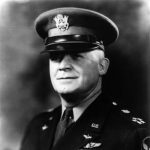 Airplanes are able to do so much more and travel so much further these days than they were in World War II. Back then, planes had to be based in nations closer to the fighting, because bomb runs could not be done from US shores…too much distance. Nevertheless, it wasn’t because no one had considered such a possibility. On September 28, 1942, General Henry “Hap” Arnold ordered the highest priority be given to the development of two exceptional aircraft. They were the B-35 Flying Wing and the B-36 Peacemaker, and they were intended for bombing runs from bases in the United States to targets in Europe. It could have potentially changed the way the war was fought…had everything worked out as planned.
Airplanes are able to do so much more and travel so much further these days than they were in World War II. Back then, planes had to be based in nations closer to the fighting, because bomb runs could not be done from US shores…too much distance. Nevertheless, it wasn’t because no one had considered such a possibility. On September 28, 1942, General Henry “Hap” Arnold ordered the highest priority be given to the development of two exceptional aircraft. They were the B-35 Flying Wing and the B-36 Peacemaker, and they were intended for bombing runs from bases in the United States to targets in Europe. It could have potentially changed the way the war was fought…had everything worked out as planned.
General Arnold was a man of distinction from the beginning of his career. Not only was he one of the first pilots in the US Signal Corps, but he was taught to fly by none other than one of the Wright brothers. During World War I, Arnold was director of aviation training for the Army. Between World War I and World War II, he was a proponent of the controversial military philosophy that emphasized strategic bombing, eliminating the need for the use of ground forces altogether. It was a noble idea, and could have potentially saved many lives, although I don’t know how feasible it really is. I think there are times when ground forces are the only way to go, but I have never fought in a war, so I could be wrong on that thought.
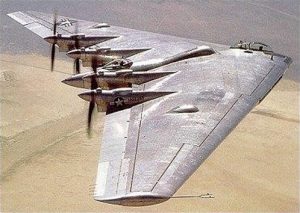
When the United States entered into World War II, the Army Air Forces had become an increasingly distinct military service. General Arnold became its first chief. Along with this honor came the opportunity of a seat with the Joint Chiefs of Staff. Initially this was intended to boost his status to that of his counterpart in Britain, but it also increased the stature and independence of the Army Air Forces. General Arnold was able to form alliances with British RAF allies who also favored the use of strategic bombing in lieu of ground-force operations.
In 1942, Arnold gave the highest priority to the development of two extra long-distance transatlantic planes that would prove most useful to his strategic bombing game plan, the B-35 Flying Wing and the B-36 Peacemaker transatlantic bombers. The B-35 had been first proposed in early 1941, intended for use in defending an invaded Britain. But the tailless design was so radical that it was viewed as…maybe not safe, so the plane was put on the back burner. When I look at the plane, I can see how it might look unsafe, and really not flight worthy.
The plans for the B-35 were finally revived because of advantages the plane afforded over the B-36 bombing range in relation to gross weight, for example. Fifteen B-35 planes were ordered for construction, but the first did not take flight until 1946, after World War II had ended. Designs for the B-36 were also developed early in 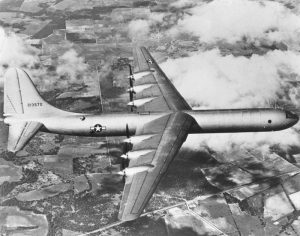 1941, on the assumption that the United States would inevitably be drawn into the war and it would need a bomber that could reach Europe from bases in America. It was to be a massive plane…162 feet long with a 230 foot wingspan. But its construction lagged, and it was not completed until after the war ended either. Although Hap’s “high priority” could not cut through the military bureaucracy of his time, 1947 would see the Nation Defense Act establish an autonomous Air Force…a dream for which he had worked. The B-35 Flying Wing would become the prototype for the B-2 Stealth bomber built in 1989. And the B-36 was used extensively by US Strategic Air Command until 1959, but the B-36 Peacemaker never dropped a bomb.
1941, on the assumption that the United States would inevitably be drawn into the war and it would need a bomber that could reach Europe from bases in America. It was to be a massive plane…162 feet long with a 230 foot wingspan. But its construction lagged, and it was not completed until after the war ended either. Although Hap’s “high priority” could not cut through the military bureaucracy of his time, 1947 would see the Nation Defense Act establish an autonomous Air Force…a dream for which he had worked. The B-35 Flying Wing would become the prototype for the B-2 Stealth bomber built in 1989. And the B-36 was used extensively by US Strategic Air Command until 1959, but the B-36 Peacemaker never dropped a bomb.
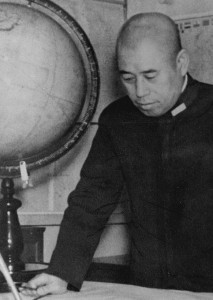 Some soldiers, no matter what side they are on or what branch of service they are in, are so good at what they do, that they become a must kill to the enemy. Admiral Isoroku Yamamoto was just such a soldier. Yamamoto held several important posts in the Imperial Japanese Navy, and undertook many of its changes and reorganizations, especially its development of naval aviation. He was the commander-in-chief during the early years of the Pacific War and so was responsible for major battles such as Pearl Harbor and Midway. That meant that the Unites States had a score to settle with the admiral. Nevertheless, this would be no easy task. The Japanese codes were difficult to break, and so locating the admiral at a time when they could be prepared to shoot him down was not going to be easy.
Some soldiers, no matter what side they are on or what branch of service they are in, are so good at what they do, that they become a must kill to the enemy. Admiral Isoroku Yamamoto was just such a soldier. Yamamoto held several important posts in the Imperial Japanese Navy, and undertook many of its changes and reorganizations, especially its development of naval aviation. He was the commander-in-chief during the early years of the Pacific War and so was responsible for major battles such as Pearl Harbor and Midway. That meant that the Unites States had a score to settle with the admiral. Nevertheless, this would be no easy task. The Japanese codes were difficult to break, and so locating the admiral at a time when they could be prepared to shoot him down was not going to be easy.
Finally, on April 18, 1943, the code breakers successfully broke the code, leaving the admiral vulnerable to attack, and Operation Vengence was born. The sole purpose of this mission was to kill Admiral Isoroku Yamamoto. The mission took place during the Solomon Islands campaign in the Pacific Theater of World War II. The code breakers found out that the admiral was set to be onboard a transport plane that would be flying over Bougainville Island. With everything finally in place, his transport bomber aircraft was shot down by United States Army Air Forces fighter aircraft operating from Kukum Field on Guadalcanal. It was a day to celebrate. The United States had been nursing a black eye where Pearl Harbor was concerned, and they had been looking to settle the score. Operation Vengence was the victory they had been waiting for.
The admiral’s death was a major blow to Japanese  military morale during World War II, and was a major boost to the Allied Forces. The operation was intended as revenge for the Pearl Harbor attack which initiated the formal state of war between Imperial Japan and the United States.
military morale during World War II, and was a major boost to the Allied Forces. The operation was intended as revenge for the Pearl Harbor attack which initiated the formal state of war between Imperial Japan and the United States.
After the war, there was debate over which of the US fighter pilots involved in the raid deserved the official credit for downing Yamamoto due to conflicting first-hand reports from the participants, and has never been entirely resolved. I suppose that for the pilots it was a big deal, but for the US citizens it wasn’t the pilot that mattered, but rather that the mission had been successful. Americans hate to lose, and we will go after the villan who dared to attack us.
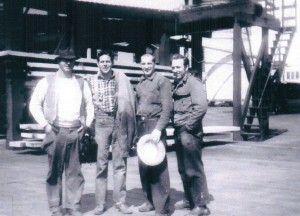 As a young man, my dad decided to broaden his horizons and so, he headed out to California, where his brother, my Uncle Bill and his wife would eventually join him. While out there, Dad worked at McDonald Douglas, helping to build airplanes. That would eventually help him in his job as flight engineer in the Army Air Forces in World War II.
As a young man, my dad decided to broaden his horizons and so, he headed out to California, where his brother, my Uncle Bill and his wife would eventually join him. While out there, Dad worked at McDonald Douglas, helping to build airplanes. That would eventually help him in his job as flight engineer in the Army Air Forces in World War II.
After the war, and after his brother, my Uncle Bill, my Dad again headed out to California to work in a lumber yard. I don’t know if this was the only job they did out there, but if it was, I would be surprised. I think most single people, especially the young ones tend to try out a few vocations, before settling on a career…and this would not be my dad’s career choice either…no would 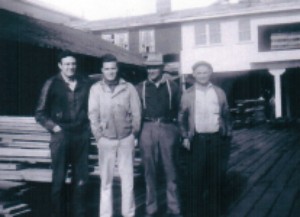 California be his choice of a place to live. Nevertheless, he and Uncle Bill did work in the lumber yard in the Eureka, California area. Their job was to pull the lumber off of the “Green Chain”. A green chain is a type of lumber delivery system used in the 19th and early to late 20th century to collect the final product of the mill and move it at a controlled rate. The men, like my dad and Uncle Bill, would stand alongside and pull lumber that matched the required dimensions and place it in piles. Basically the lumber was sorted by hand. Modern sawmills use automatic systems to place the lumber in an area where it can dry. The green chain was most likely called that because it was a way of setting the green lumber in a staging area for drying before it could be used. I would think that this type of job would be rather boring, and that is also most likely why they didn’t stay in that career.
California be his choice of a place to live. Nevertheless, he and Uncle Bill did work in the lumber yard in the Eureka, California area. Their job was to pull the lumber off of the “Green Chain”. A green chain is a type of lumber delivery system used in the 19th and early to late 20th century to collect the final product of the mill and move it at a controlled rate. The men, like my dad and Uncle Bill, would stand alongside and pull lumber that matched the required dimensions and place it in piles. Basically the lumber was sorted by hand. Modern sawmills use automatic systems to place the lumber in an area where it can dry. The green chain was most likely called that because it was a way of setting the green lumber in a staging area for drying before it could be used. I would think that this type of job would be rather boring, and that is also most likely why they didn’t stay in that career.

The thing that I found most interesting about these pictures, is not what the men were doing, but rather that I had to read the list of men in the picture before it hit me that one of them was my dad. I suppose it could be that the picture wasn’t of the best quality, but I really think that it was because my dad was so much younger in the picture. He was very handsome, and I could see why my mother fell for him the minute she saw him. He was rugged and friendly, with a nice smile. I am glad that he and Uncle Bill didn’t stay in California, because then he wouldn’t have met my mom, and my sisters and I would not have been born.

